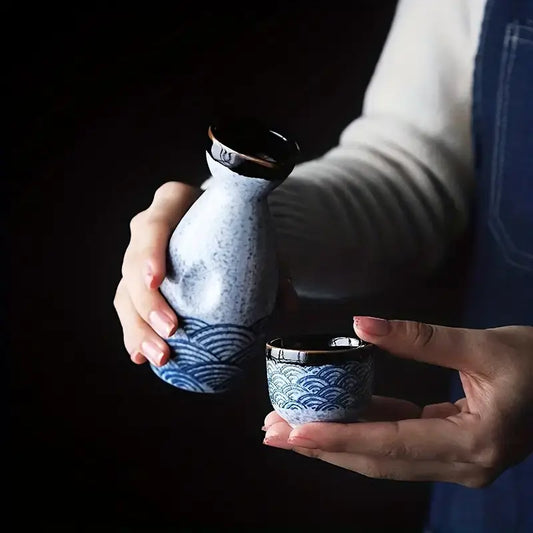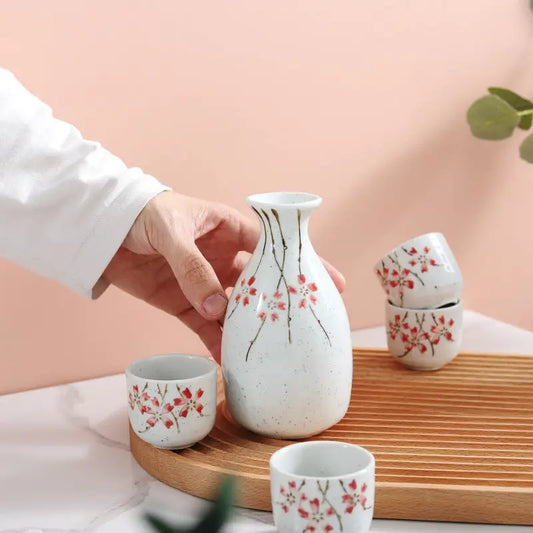Pour with Tradition: Explore Our Sake Set Collection 🍵🌟
Welcome to a world where ritual meets relaxation—our curated collection of sake sets brings the timeless elegance of Japanese drinking culture into your home ✨. Whether you're a connoisseur of premium sake or new to the tradition, our sake sets offer a stylish, meaningful way to enjoy every pour 🍵.
Perfect for quiet evenings, celebrations, or gifting, each set is crafted to elevate the experience of savoring sake—with designs that range from rustic and traditional to sleek and modern 🎨.
What is a Sake Set? 🍵🥂
A sake set is a collection of tableware used to serve and drink sake, Japan’s traditional rice wine. Typically, it includes:
-
A tokkuri (carafe or bottle) for pouring
-
One or more ochoko (small cups) for sipping
-
Optional tray or warmer for presentation or temperature control
Sake sets may be made from ceramic, porcelain, glass, or stoneware, each lending a unique feel and aesthetic to the drinking ritual 🌟.
Why You’ll Love Our Sake Sets 😍🍵
Cultural Elegance: Sip with intention using vessels inspired by centuries of tradition and ceremony 🥂.
Perfect for Hosting: Share warm or chilled sake with friends or guests in beautifully coordinated sets 🥂.
Gifting Ready: A thoughtful and refined gift for weddings, birthdays, housewarmings, or anniversaries 🎁.
Aesthetic Appeal: Choose from minimalist stoneware, delicate porcelain, rustic glazes, or contemporary designs 🎨.
Temperature Versatility: Great for warm or cold sake—many sets are microwave- or dishwasher-safe for convenience 🛌.
Sake Set Styles & Materials 🍵🖼️
| Style | Material | Best For |
|---|---|---|
| Traditional Ceramic | Glazed earthenware | Rustic, warm sake settings |
| Minimalist Porcelain | White or black porcelain | Modern homes and gifting |
| Stoneware Artisan Sets | Textured, hand-thrown | Japanese-style dining or tea rooms |
| Glass Sets | Clear or frosted glass | Chilled sake, summer use |
| Travel or Gift Sets | Compact with case | Gifting, portable occasions |
Serving Tips & Traditions 🍵✨
-
Serve warm or chilled: Use warm sake in winter, and cold in summer depending on sake type.
-
Pour for others: In Japanese tradition, it's polite to pour sake for someone else before your own cup is filled.
-
Choose the right cup: Small ochoko cups for traditional feel, or wide-mouthed sakazuki for ceremonial toasts.
-
Use a warmer: Heat your tokkuri in hot water for gentle warming—never microwave sake directly unless the set is microwave-safe.
Pair It With: The Perfect Sake Night 🍵🍣
Create a complete experience with:
-
Sushi Boats or Nigiri Plates: Serve complementary dishes in authentic style 🍣
-
Soy Sauce Dishes & Chopsticks: For dipping, tasting, and adding flair 🍽️
-
Candlelight or Incense: Set the mood for a peaceful evening ritual 🕯️
-
Sake Warmers or Trays: Elevate the look and temperature control ❄️🔥
Sip the Tradition, Savor the Moment 🍵🌟
Sake is more than a drink—it's a moment of pause, connection, and appreciation. Whether you're sharing stories over a warm pour or enjoying a solo toast to the day, our sake sets invite you to slow down and enjoy with grace ✨.
Browse our collection and find the set that matches your ritual, your table, and your taste 🍵.















